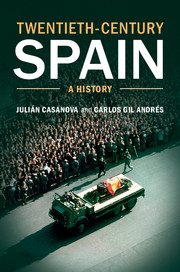Book contents
- Frontmatter
- Contents
- List of illustrations
- Key figures
- List of abbreviations
- Twentieth-century Spain timeline
- Maps
- Introduction
- Part I The monarchy of Alfonso XIII
- Part II The Second Republic
- Part III The Civil War
- Part IV Franco’s dictatorship
- 10 Franco’s peace
- 11 ‘The spiritual reserve of the world’
- 12 The death throes of Francoism
- Part V Transition and democracy
- Guide to further reading
- Index of names and authors
- References
10 - Franco’s peace
Published online by Cambridge University Press: 05 July 2014
- Frontmatter
- Contents
- List of illustrations
- Key figures
- List of abbreviations
- Twentieth-century Spain timeline
- Maps
- Introduction
- Part I The monarchy of Alfonso XIII
- Part II The Second Republic
- Part III The Civil War
- Part IV Franco’s dictatorship
- 10 Franco’s peace
- 11 ‘The spiritual reserve of the world’
- 12 The death throes of Francoism
- Part V Transition and democracy
- Guide to further reading
- Index of names and authors
- References
Summary
The Spanish Civil War was followed by a long uncivil peace. Franco’s dictatorship was the only one in Europe to emerge from a civil war, establish a repressive state from the ashes of this war, relentlessly persecute its opponents and mete out cruel and bitter punishment on the vanquished until the end. There were other dictatorships – some fascist, some not – but not one of them arrived as a consequence of civil war. And there were other civil wars, but not one of them followed a coup d’état, nor produced such a violent and long-lasting reactionary outcome.
In short, in Franco’s long and cruel dictatorship lies the exceptional nature of Spain’s twentieth-century history in comparison to that of other European capitalist countries. It is true that, unlike Finland and Greece, nations that also suffered civil wars in the first half of the century, Spain was never able to enjoy the benefit of an international democratic intervention that would block the authoritarian outcome at the end of a civil war. But more than anything else it was the victors’ commitment to revenge, with no pardon or reconciliation on offer, that should be emphasised along with their desire to hold on to the power that armed conflict gave them for as long as possible. For decades, the army, the Catholic Church and Franco made coexistence very difficult. It was their attitudes, and those of hundreds of thousands who supported them, that really made Spain different.
- Type
- Chapter
- Information
- Twentieth-Century SpainA History, pp. 219 - 248Publisher: Cambridge University PressPrint publication year: 2014



